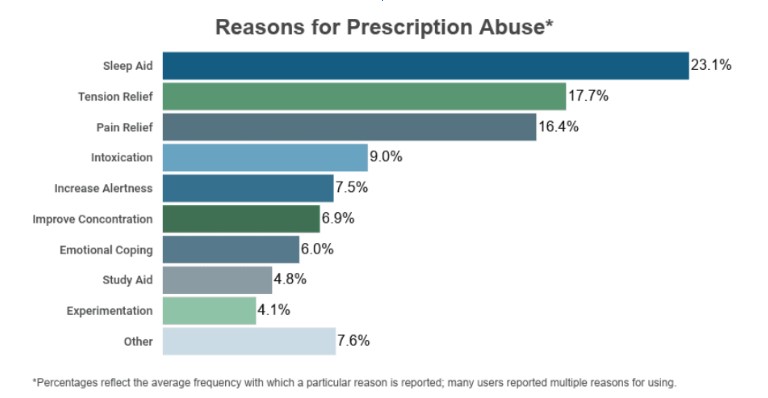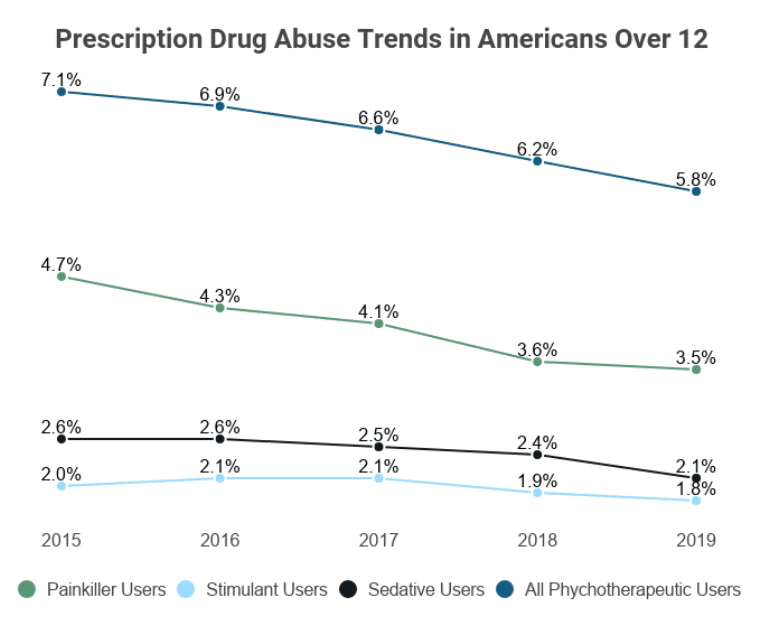Mina Draskovic, B.Psy., reviewed this content for accuracy on May 14, 2024
Prescription drug addiction is a growing problem that affects millions of people worldwide. According to the NCDAS, 12% of prescription drug abusers in America become addicted. That’s more than two million people, on average.
Many of these people are prescribed opioid painkillers and benzodiazepines for managing pain or treating anxiety. The misuse of these drugs can quickly spiral out of control, leading to devastating consequences.
Addiction to prescription drugs may not always be easy to kick. If you find yourself struggling to overcome this challenge, our prescription drug addiction program provides the support and guidance you need.
Prescription drugs are medications that require a medical prescription from a licensed healthcare provider. They are regulated by the government and intended to treat specific health conditions or manage symptoms.
Several types of prescription drugs that are commonly prescribed by doctors include:
Nearly all prescription drugs have the potential for abuse and addiction, especially if they are not used as directed. Even when a medication is prescribed to you, if you take more than the recommended dose and use it more frequently than advised, you may develop a physical and psychological dependence on the drug.
Prescription medicine includes many types of drugs, but there are some general physical and behavioral indicators that point to abuse and addiction.
Physical signs of prescription drug addiction may include:
People often show symptoms of prescription drug addiction in behavior. They:
If you notice these signs in someone you care about, encourage them to seek help. It can be hard to break free from addiction, but there is hope. Our Utah rehab center welcomes anyone struggling with drug or alcohol addiction who’s ready to start healing. Nestled in the heart of Utah Valley’s mountains, our facility provides a serene and ideal environment for healing the mind, body, and spirit.
Contact Ardu today and reclaim your health and happiness.
Prescription drugs can be highly addictive, but not everyone who takes them will develop an addiction. Addiction is a complex brain disorder influenced by biological, psychological, and social factors such as genetics, environment, and personal history.

Here are the main reasons why people become addicted to prescription medications:
A lot of people hooked on prescription medications are also dealing with mental health issues. Addiction and mental illness feed off each other in an endless loop. Left untreated, the two issues can make recovery extremely difficult.
At Ardu, we don’t treat just the substance abuse—we look at the whole person. Our specialized dual diagnosis treatment programs tackle addiction and mental health simultaneously, giving you the complete care you need to get your life back on track.
Learn more about our co-occurring disorder treatments and what they entail.
The National Center on Drug Abuse Statistics (NCDAS) points to the severity of the prescription drug addiction problem as one of the major public health crises in America. In 2019, 16.3 million Americans (5.76%) aged 12 and older misused prescription drugs.
Nearly 2 million of those who misused prescriptions developed an addiction. Only 12.7% of them acknowledged their addiction.

There is some good news, though: prescription drug abuse has declined in recent years. In 2015, nearly 19 million people misused prescriptions, so the numbers have dropped by 13.8%. The rates of first-time abuse remain high: 22.6%.
While the decline in overall misuse is a positive step, the staggering numbers of those abusing opioid painkillers and other prescription meds are concerning. Prescription drug addiction can rapidly spiral out of control, ravaging lives, families, and communities.
Prescription drug addiction can be devastating to every aspect of a person’s life. consequences ripple out from the addict, impacting their loved ones, communities, and society at large.
Here are some of the major fallouts of prescription drug abuse and addiction.
Prescription drug addiction wreaks havoc on the body. The toxic effects of misusing opioids and stimulants can damage vital organs such as the liver, kidneys, and heart. The risk of contracting infections from sharing needles or engaging in other hazardous behaviors is high. Stimulant abuse can cause cardiovascular issues such as irregular heartbeat, heart failure, and increased risk of stroke. Long-term prescription drug abuse takes an immense toll, causing physical deterioration, hormonal imbalances, and dramatically shortened life expectancy.
The most dangerous consequence of prescription drug abuse is the ever-present threat of overdose.
Many prescription drugs are a significant risk factor for overdose. Oxycodone and hydrocodone can cause life-threatening respiratory depression in overdose. Benzodiazepines such as Xanax or Valium can cause severe sedation and coma. Even medications not typically associated with overdoses (e.g. antidepressants or anti-seizure drugs) can potentially be fatal if taken in excess.
Not all prescription drugs have the same signs of overdose, but here are some signs of a prescription drug overdose:
If you suspect someone has overdosed, call 911 right away.
Addiction to prescription medications inflicts severe damage on mental health and cognitive functioning. For those already struggling with depression, anxiety, or bipolar disorder, prescription drug abuse only intensifies and destabilizes these mental health disorders.
Substance abuse can also trigger the onset of terrifying new psychological disorders such as paranoid delusions, hallucinations, and psychotic breaks with reality. Basic cognitive abilities start to deteriorate: thought processes become muddled, concentration lapses, and normal daily functioning grows increasingly difficult. People addicted to prescription drugs have trouble regulating emotions, while their decision-making skills become impaired.
Prescription drug addiction erodes relationships and severs social connections. As the disease takes hold, addicts become increasingly unreliable—they miss important events, lash out at loved ones, lie, and exhibit volatile mood swings. This erratic behavior puts a strain on familial and platonic bonds.
Addiction can also impact job performance through absenteeism, negligence, and impaired cognitive abilities, often resulting in termination and financial ruin. The stigma surrounding addiction alienates many from their support systems, as loved ones who cannot understand the disease recoil in judgment.
Prescription drug addiction can quickly lead down a path of legal troubles and financial ruin. Addicts often resort to “doctor shopping” by fraudulently obtaining prescriptions from multiple providers, risking charges of fraud and drug possession. Some turn to forging prescriptions or theft to maintain their habit.
The high cost of feeding an addiction drains finances rapidly, leading to debt from neglecting bills and responsibilities. Many people addicted to prescription meds lose their jobs because of their unreliable performance. The simultaneous legal consequences and financial devastation have a shattering impact on entire families, not only on the ones addicted.
People often do not recognize or admit they need help until the addiction has already taken hold. You don’t have to go through this alone. The team at Ardu Recovery Center has the expertise and compassion to guide you through recovery.
We provide a safe, judgment-free environment to detox and break free from the grip prescription medications can have. With comprehensive, evidence-based rehab programs and a supportive community, Ardu equips you with all the tools you need to regain control of your life.
To help you kick addiction to prescription drugs, we employ:
You’ve already taken that first brave step by acknowledging the problem. We are here to walk alongside you, empowering you to overcome this challenge and achieve lasting recovery. The first step in getting you clean is detox.
Recovery from prescription drug addiction starts with a safe, medically supervised detox. The medical team at our drug detox program will first evaluate your situation and create an individualized detox plan tailored specifically for you. Then, around-the-clock care and medication assistance make withdrawal much more manageable by relieving those brutal symptoms.
We combine the medical approach with holistic detox practices such as nutritional support, massage, and yoga therapy to help restore your mind and body’s balance. These natural methods promote healing as your system acclimates to being substance-free again.
With Ardu’s comprehensive prescription drug detox, you’ll have the medical oversight and therapeutic support you need to get through this challenging phase. Our goal is to set you up for success as you transition into an effective long-term treatment program after detox.
At our rehab facility, we provide comprehensive inpatient and outpatient treatment options to help you overcome prescription drug addiction.
No matter the treatment setting, our approach integrates evidence-based therapies tailored to prescription drug addiction:
With a comprehensive range of therapies, we give you the best chance at achieving long-term sobriety. Contact Ardu and start your journey towards lasting recovery. If you want to verify your health insurance coverage, gather more payment information, and pursue the Medicaid redetermination process in Utah, visit our insurance verification page.
The most common prescription drug addiction is to opioid painkillers such as oxycodone, hydrocodone, morphine, and fentanyl. Their euphoric and sedative effects, combined with the potential for physical dependence and tolerance, make them highly addictive substances.
Pharmacy addiction is the misuse, abuse, or addiction to prescription medications obtained from legitimate pharmacies, either through one’s own prescription or illegally obtaining medications. It includes addictions to opioid pain relievers, stimulants, sedatives, and other controlled psychotherapeutic drugs dispensed by pharmacies.
Prescription drugs of abuse, especially opioids and stimulants, affect the brain’s dopamine system and reward pathways in powerful ways. Opioids flood the brain with dopamine, producing euphoria. Stimulants such as Adderall increase dopamine and norepinephrine activity, but with repeated abuse, the brain reduces dopamine receptors and increases reuptake to compensate, decreasing pleasure from natural rewards and driving compulsive drug use.
According to the data, prescription drug misuse is highest among young adults aged 18-25, with 14.4% reporting abuse annually. This age group is also more prone to stimulant abuse, with 40.8% of stimulant abusers falling in this range. Overall, 5.76% of Americans over age 12 misused prescription drugs.
Addiction changes the brain in several ways.
These brain changes drive the compulsive behavior pattern characteristic of addiction.
Many addictive drugs directly or indirectly increase dopamine levels in the brain’s reward pathways, producing euphoria. Opioids, stimulants, alcohol, nicotine, and many other drugs of abuse impact dopamine signaling. Even behaviors like gambling and binge eating affect dopamine. This contributes to their reinforcing effects and addictive potential.
Addiction has a genetic component. While environmental influences play a major role, genes affecting dopamine receptors, neurotransmitter systems, mental illness, and impulsivity can increase vulnerability to developing addictions. There seem to be specific gene variants that influence how the brain responds to addictive substances and behaviors.
Genetic risk is just one piece. Environmental stressors, mental health conditions, social circles, and early exposure to drugs also shape addiction risk. Genetics loads the gun, but life circumstances often pull the trigger when it comes to developing a substance use disorder.
Prescription Drug Abuse Statistics – NCDAS. (2024, May 2). NCDAS. https://drugabusestatistics.org/prescription-drug-abuse-statistics/
Volkow, N. D., Michaelides, M., & Baler, R. (2019). The Neuroscience of Drug Reward and Addiction. Physiological Reviews, 99(4), 2115-2140. https://doi.org/10.1152/physrev.00014.2018
Drug Use Changes the Brain Over Time. (n.d.). https://learn.genetics.utah.edu/content/addiction/brainchange
Drazdowski TK, Schulte M, Wolitzky-Taylor KB, Schaper H, Chapman JE. Motivations for Prescription Drug Misuse Related to Mental Health Problems in Adults. Subst Use Misuse. 2022;57(2):316-327. doi: 10.1080/10826084.2021.2012687. Epub 2021 Dec 14. PMID: 34903123; PMCID: PMC8842830.
What are the symptoms of alcohol withdrawal?
What are the signs that your body is detoxifying?
Why should you never detox alone?
What to look for in teen addiction